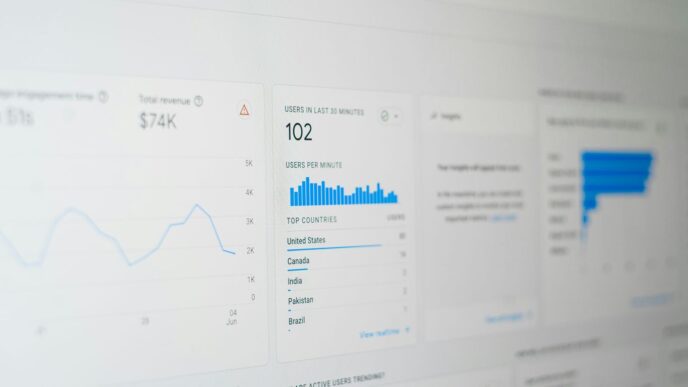Getting your head around social media marketing in 2025 feels like a big task, right? It’s always changing. This guide is here to help you figure it all out, from the basics to the latest trends. We’ll cover how to make plans that actually work, how to use platforms like Facebook and Instagram effectively, and how to tie it all into your bigger marketing picture. Plus, we’ll talk about how a good social media marketing course can give you the skills you need to succeed. Let’s get started on making your social media efforts work better.
Key Takeaways
- Understand the core ideas of social media marketing to build a solid plan for 2025.
- Learn how to create specific strategies for platforms like Facebook, Instagram, LinkedIn, and Twitter (X).
- See how social media fits into your overall digital marketing efforts for a consistent message.
- Stay updated with new trends and use data to make your social media campaigns better.
- Recognize the value of a social media marketing course in developing practical skills and getting certified.
Understanding Core Social Media Marketing Concepts
Defining Your Social Media Marketing Blueprint
Before you even think about posting, you need a plan. This isn’t just about picking a few platforms and hoping for the best. It’s about figuring out what you want to achieve and who you’re trying to reach. Think of it like drawing a map before you start a road trip. You wouldn’t just hop in the car and drive, right? You’d decide where you’re going, how you’ll get there, and what you need to pack. Your social media blueprint is the same. It’s the foundation for everything you’ll do online.
A solid blueprint starts with understanding your audience and setting clear, measurable goals. What do you want social media to do for your business? More website traffic? Better brand recognition? Increased sales? Be specific. Then, figure out who you’re talking to. What are their interests? Where do they hang out online? Knowing this helps you tailor your message and choose the right platforms.
Developing Actionable Social Media Plans
Once you have your blueprint, it’s time to get down to the nitty-gritty: the actual plan. This is where you translate your big ideas into concrete steps. It’s not enough to say ‘I want more followers.’ You need to figure out how you’re going to get them. This involves deciding on the types of content you’ll create, how often you’ll post, and what your budget will be.
Here’s a quick look at what goes into an actionable plan:
- Content Calendar: Map out your posts in advance. This helps you stay consistent and ensures you’re covering all your bases.
- Platform Selection: Based on your audience research, choose the platforms where you’ll focus your efforts. You don’t need to be everywhere.
- Engagement Strategy: How will you interact with your audience? Responding to comments and messages is key.
- Measurement Metrics: How will you know if your plan is working? Define the key performance indicators (KPIs) you’ll track.
Exploring Diverse Social Media Approaches
Social media isn’t one-size-fits-all. Different platforms have different vibes and attract different people. What works on Instagram might fall flat on LinkedIn. You need to understand these differences and adapt your approach accordingly. Are you aiming for a professional audience? LinkedIn is probably your best bet. Trying to reach a younger demographic with visual content? Instagram and TikTok might be more suitable. It’s about meeting your audience where they are, with content that makes sense for that specific space.
Think about these different approaches:
- Community Building: Focusing on creating a loyal following and encouraging interaction.
- Content Marketing: Sharing informative or entertaining content to attract and engage an audience.
- Paid Advertising: Using social media ads to reach a wider or more targeted audience.
- Influencer Marketing: Partnering with individuals who have a significant following to promote your brand.
Mastering Platform-Specific Strategies
Each social media platform has its own vibe and its own way of doing things. You can’t just post the same thing everywhere and expect it to work. It’s like trying to wear a tuxedo to a beach party – it just doesn’t fit.
Crafting an Effective Facebook Strategy
Facebook is still a big deal, especially for reaching a wide audience. Think about building a community here. It’s not just about selling; it’s about connecting. You’ll want to use a mix of content: videos, good photos, and posts that ask questions to get people talking. Facebook Groups can be goldmines for niche audiences.
Here’s a quick breakdown:
- Know Your Audience: Who are you trying to reach on Facebook? What are they interested in?
- Content Mix: Don’t just push products. Share helpful tips, behind-the-scenes looks, and user-generated content.
- Engagement is Key: Respond to comments and messages quickly. Run polls and Q&As.
- Facebook Ads: Use targeted ads to reach specific demographics and interests.
Optimizing Instagram Marketing Campaigns
Instagram is all about visuals. If your product or service looks good, this is your playground. High-quality photos and short, engaging videos (Reels!) are a must. Stories are great for showing off daily happenings and running quick polls or quizzes.
- Visual Storytelling: Make sure your images and videos are top-notch.
- Hashtag Strategy: Use a mix of popular and niche hashtags to get discovered.
- Reels and Stories: These formats get a lot of attention. Experiment with trends.
- Influencer Collaborations: Partnering with the right influencers can boost your reach.
Leveraging LinkedIn for Professional Networking
LinkedIn is where you go for business. It’s perfect for B2B marketing, recruiting, and building your company’s professional image. Think articles, industry insights, and company news. It’s less about casual chat and more about establishing credibility.
- Thought Leadership: Share your company’s expertise and insights.
- Company Page: Keep your company page updated with news and job openings.
- Networking: Connect with industry peers, potential clients, and employees.
- LinkedIn Ads: Target professionals based on their industry, job title, and company size.
Developing a Twitter (X) Strategy
Twitter (now X) is fast-paced. It’s great for real-time updates, customer service, and joining conversations. Short, punchy messages work best here. You can also use it to share links to longer content on your website.
- Timeliness: Jump on trending topics when relevant.
- Customer Service: Respond quickly to customer inquiries and complaints.
- Concise Messaging: Get your point across in few words.
- Link Sharing: Drive traffic to your blog posts or website.
Integrating Digital Marketing Strategies
So, you’ve got your social media game plan, right? That’s awesome. But here’s the thing: social media doesn’t live in a vacuum. It’s just one piece of a much bigger puzzle, the whole digital marketing picture. To really make things work, you’ve got to make sure your social media efforts are playing nice with everything else you’re doing online.
Aligning Social Media Tactics with Overall Goals
Think about what you’re trying to achieve with your business. Are you trying to sell more stuff? Get more people to sign up for your newsletter? Build brand awareness? Whatever it is, your social media actions need to point in that same direction. It’s like having a team where everyone needs to be rowing the same way. If your main goal is sales, then your Instagram posts should probably be showing off products and making it easy to buy, not just posting pretty pictures with no call to action.
Here’s a quick way to check if things are lined up:
- What’s the big business objective? (e.g., Increase Q4 sales by 15%)
- What’s the specific social media goal supporting that? (e.g., Drive 500 website clicks from Facebook ads to product pages)
- Are your social media activities directly contributing to that goal? (e.g., Are the ads relevant to the products and landing page?)
Creating Cross-Platform Content Synergy
This is where things get interesting. Instead of just posting the same old thing everywhere, you want your content to flow and make sense across different platforms. It’s not about duplicating content, but about adapting it. A long-form blog post might become a series of tweets, an Instagram carousel, and a LinkedIn article summary. The idea is to create a consistent brand voice and message that feels familiar to your audience, no matter where they encounter you.
Consider this breakdown:
| Platform | Content Type Examples |
|---|---|
| Community building posts, event promotion, customer stories | |
| Visually appealing product shots, behind-the-scenes stories | |
| Industry insights, company news, professional advice | |
| Twitter (X) | Quick updates, customer service interactions, trending topics |
Implementing Unified Digital Marketing Strategies
This is the big picture stuff. It means looking at your website, your email marketing, your SEO, your paid ads, and your social media all together. Are they working in harmony? For example, if someone clicks on a social media ad and lands on your website, does the website experience match the ad’s promise? Is your email list being nurtured with content that aligns with what you’re posting on social? When all these different digital marketing channels work together, they become much more powerful than if they were just doing their own thing. It creates a smoother journey for your potential customers and makes your overall marketing efforts way more effective.
Leveraging Emerging Trends and Analytics
The social media landscape changes faster than you can say ‘viral post’. Keeping up with what’s new and understanding what the numbers actually mean is super important if you don’t want your marketing efforts to fall flat. It’s not just about posting; it’s about posting smart and knowing if it’s working.
Staying Ahead with Social Media Marketing Trends
So, what’s hot in 2025? Think AI-powered content creation, more personalized user experiences, and the continued rise of short-form video. Brands are also looking at how to make their content more accessible and inclusive. It’s a lot to track, but paying attention to these shifts can make a big difference.
- AI in Content Generation: Tools are getting better at helping you write copy, suggest visuals, and even plan your posting schedule. This can save a ton of time.
- Personalization: Users expect content tailored to their interests. This means digging into your audience data to deliver what they actually want to see.
- Video Dominance: Short-form video continues to be king, but longer, more in-depth video content is also finding its audience.
- Community Building: Moving beyond just broadcasting, brands are focusing on creating genuine connections and fostering communities around their products or services.
Utilizing Advanced Analytics for Optimization
Numbers, numbers everywhere. It can feel overwhelming, but analytics are your best friend. They tell you what’s working and, more importantly, what’s not. Don’t just look at likes; dig deeper into metrics that actually impact your business goals. Understanding your audience’s behavior through data is key to refining your strategy.
Here’s a quick look at some important metrics:
| Metric | What it Tells You |
|---|---|
| Engagement Rate | How much your audience interacts with your content |
| Click-Through Rate | How many people click on your links |
| Conversion Rate | How many people take a desired action (e.g., buy) |
| Reach & Impressions | How many people see your content |
Adapting to Real-Time Data Insights
Social media doesn’t sleep, and neither should your strategy. Being able to react quickly to what’s happening right now is a huge advantage. This means monitoring conversations, spotting trends as they emerge, and adjusting your content on the fly. It’s about being agile and responsive. For example, if a particular topic suddenly becomes a big deal, you can jump in with relevant content. This kind of real-time adaptation can significantly boost your social media marketing statistics.
- Monitor Mentions: Keep an eye on what people are saying about your brand and your industry.
- Track Trends: Use social listening tools to identify trending topics and conversations.
- Adjust Content: Be ready to tweak your planned posts or create new content based on current events or audience reactions.
- Respond Quickly: Engage with comments and messages promptly to show you’re listening.
Enhancing Skills Through Training
Look, nobody’s born knowing how to make a killer TikTok or a Facebook ad that actually gets clicks. It takes practice, and honestly, a bit of guidance. That’s where training comes in. It’s not just about learning the basics; it’s about getting the inside scoop on what’s working now and what’s coming next. Investing in the right training can seriously change your game.
Benefits of Classroom Digital Marketing Training
While online courses are great, there’s something about being in a room with other people trying to figure this stuff out. You get to ask questions on the spot, and sometimes, just hearing someone else’s problem can spark an idea for your own campaigns. Plus, you get direct feedback from instructors who are actually in the trenches.
- Real-time Q&A: No waiting for email replies. Get your questions answered immediately.
- Networking: Meet other marketers, potential collaborators, or even future employers.
- Structured Learning: A clear path from beginner to more advanced topics, without getting lost down internet rabbit holes.
- Hands-on Practice: Many programs include exercises and case studies you can work through.
Choosing the Right Social Media Marketing Course
So, how do you pick the right one? It can feel overwhelming with so many options out there. Think about what you really need to learn. Are you trying to get better at Instagram ads, or do you need a broader understanding of digital marketing as a whole? Check out what skills the course promises you’ll gain. Some courses focus on specific platforms, while others give you a wider view. You can find a lot of great options, including some that are free to start, which is pretty neat if you’re just dipping your toes in. Check out free courses.
Skills Gained from Professional Certificates
Getting a certificate isn’t just about adding a line to your resume, though that’s nice too. It means you’ve gone through a structured program and proven you know your stuff. You’ll likely walk away with skills like:
- Content Creation: Knowing how to make posts that grab attention.
- Audience Targeting: Figuring out who you’re actually trying to reach.
- Campaign Management: Planning, running, and tracking your social media efforts.
- Analytics Interpretation: Understanding what the numbers mean and how to use them to improve.
- Platform Specifics: Deep dives into how Facebook, Instagram, LinkedIn, and X (formerly Twitter) actually work for marketing.
Executing Your Social Media Action Plan
So, you’ve got this awesome strategy mapped out. That’s great! But a plan sitting on a shelf doesn’t do much, right? This is where the rubber meets the road – turning all that planning into actual, visible action. It’s about making sure every post, every interaction, and every campaign is working towards what you set out to achieve. The real magic happens when strategy meets consistent execution.
Think of it like building something. You need the blueprints, sure, but then you need to pick up the tools and start constructing. For social media, this means getting your content out there, engaging with people, and keeping a close eye on how it’s all performing. It’s not just about posting; it’s about posting with purpose.
Here’s a breakdown of what that looks like:
- Content Deployment: This is the actual publishing of your planned content across your chosen platforms. It involves scheduling posts, creating stories, and going live when you said you would. Consistency here is key to building an audience that knows when to expect something from you.
- Community Engagement: Social media isn’t a one-way street. You need to be actively responding to comments, messages, and mentions. This builds relationships and shows people you’re listening. It’s about having actual conversations, not just broadcasting.
- Performance Monitoring: You can’t improve what you don’t measure. This means regularly checking your analytics to see what’s working and what’s not. Are people liking your posts? Are they clicking through to your website? This data is gold.
Transforming Strategy into Execution
This is the part where you actually do the work. It’s easy to get caught up in the planning phase, but eventually, you have to start posting. This involves:
- Content Calendar Activation: Taking your content calendar and making sure each piece of content is ready to go and published on time.
- Active Listening and Responding: Setting aside time each day to monitor mentions, comments, and direct messages. Quick responses make a big difference.
- Community Building: Proactively engaging with other accounts, joining relevant conversations, and participating in groups to expand your reach and build connections.
Measuring Success with Key Performance Indicators
How do you know if your efforts are paying off? You need to look at the numbers. These aren’t just random stats; they’re indicators of whether you’re hitting your goals. Some common ones include:
| Metric | What it Tells You |
|---|---|
| Engagement Rate | How much your audience interacts with your content |
| Reach | How many unique people saw your content |
| Website Clicks | How many people went from social to your site |
| Conversion Rate | How many people took a desired action (e.g., buy) |
| Follower Growth | How quickly your audience is expanding |
Looking at these metrics helps you understand what’s connecting with your audience and what’s falling flat. It’s all about getting a clear picture of your social media performance for 2025.
Continuous Optimization of Social Media Tactics
Social media isn’t a ‘set it and forget it’ thing. The landscape changes constantly, and so should your approach. Based on the data you collect from your KPIs, you’ll want to make adjustments. Maybe a certain type of post gets way more shares, or perhaps a particular time of day sees higher engagement. You’ll want to do more of what works and less of what doesn’t. This ongoing process of tweaking and refining is what keeps your social media efforts effective and relevant over time. It’s about being agile and ready to adapt.
Wrapping It Up
So, that’s the rundown on making social media work for you in 2025. It’s not just about posting pretty pictures anymore; it’s about having a real plan. We talked about how to get all your different social accounts playing nice together, from Facebook to LinkedIn, and why keeping up with what’s new is super important. Remember, things change fast online, so staying curious and learning new tricks is key. By putting these ideas into practice, you’re setting yourself up for better connections with people and a stronger online presence. Go out there and make it happen!
Frequently Asked Questions
What’s the main goal of social media marketing?
The main goal is to connect with people online, build your brand’s reputation, and encourage them to become customers. It’s about making your business known and liked on platforms where people spend their time.
Why is it important to have a plan for social media?
Having a plan is super important because it helps you know exactly what you want to achieve and how you’ll do it. Without a plan, you might just post randomly and not get the results you want. It guides your actions and makes sure you’re working towards your goals.
How do different social media platforms work differently?
Each platform is like a different neighborhood. Facebook is great for sharing lots of info and building communities. Instagram is all about cool pictures and short videos. LinkedIn is for professional connections and business talk. Twitter (X) is for quick updates and conversations. Knowing this helps you share the right stuff on the right platform.
What does ‘cross-platform content synergy’ mean?
It means making sure your message is consistent and works well across all the social media sites you use. Think of it like telling the same story but in different ways that fit each platform, so people get the same great impression no matter where they see you.
Why should I pay attention to new social media trends?
Social media changes all the time! New trends pop up, and people start using platforms in new ways. If you don’t keep up, your marketing can start to feel old and boring. Staying updated helps you use the latest tools and ideas to reach people effectively.
What are ‘Key Performance Indicators’ (KPIs) in social media?
KPIs are like your report card for social media. They are specific numbers that tell you if your efforts are working. For example, KPIs could be how many people liked your posts, how many visited your website from social media, or how many actually bought something. They help you see what’s working and what needs to be improved.














